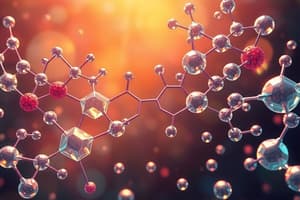Podcast
Questions and Answers
What is the origin of the word 'drug'?
What is the origin of the word 'drug'?
Drogue, meaning 'a dry herb'
According to WHO, how is a drug defined?
According to WHO, how is a drug defined?
A substance, material or product used to modify or explore physiological processes or pathological states.
All drugs are poisons, but not all poisons are drugs.
All drugs are poisons, but not all poisons are drugs.
True (A)
Which of the following is NOT a general feature of a drug?
Which of the following is NOT a general feature of a drug?
What is the ideal molecular weight range for drugs?
What is the ideal molecular weight range for drugs?
What influences the interaction between drug and receptor?
What influences the interaction between drug and receptor?
Which type of drug is retained more in the body?
Which type of drug is retained more in the body?
What is the difference between local effect and systemic effect of drugs?
What is the difference between local effect and systemic effect of drugs?
Which level of drug action involves ion channels and enzymes?
Which level of drug action involves ion channels and enzymes?
What happens when a ligand binds to a ligand-gated ion channel?
What happens when a ligand binds to a ligand-gated ion channel?
Flashcards are hidden until you start studying
Study Notes
Drug Definition and Origin
- The term "drug" originates from "Drogue," meaning ‘a dry herb.’
- WHO defines a drug as a substance used to modify physiological processes for the recipient's benefit.
- All drugs are considered poisons, but not all poisons qualify as drugs.
General Features of Drugs
- Molecular Size: Smaller molecules are absorbed more easily; ideal molecular weight is between 100-1000 Da (e.g., streptokinase: 47,286.7 Da vs. nitric oxide: 30.01 Da).
- Shape: Drugs can be globular or linear, modifying their shape based on receptor interaction. Examples include pH and temperature-responsive polymeric drugs.
- Chemical Nature: The pharmacophore is essential for optimal interactions with biological targets, influencing drug efficacy (e.g., different effects of benzoic acid vs. 5-chloro salicylic acid).
- Lipid/Water Partition Coefficient (log P): Lipid soluble drugs are retained in the body, while water-soluble drugs are more readily excreted.
- Degree of Ionization: Ionized drugs are polar and water-soluble, whereas unionized drugs are less polar and lipid-soluble; ions can pass through specific channels.
- Physical Properties: Drugs can exist as solids, liquids, or gases. Gas diffusion rates surpass those of liquids and solids.
Drug Effects
- Local Effect: Occurs at the site of application, affecting specific tissues.
- Systemic Effect: Drug action spreads throughout the body, typically via bloodstream circulation.
Mechanisms of Drug Action
- Molecular Level: Drug action involves ion channels, enzymes, and carrier molecules (e.g., aspirin inhibits COX).
- Cellular Level: Interaction with cell types, such as smooth muscle cells (e.g., calcium channel blockers).
- Tissue Level: Effects include contraction, secretion, and metabolic activity (e.g., salbutamol's bronchodilation).
- System Level: Alters functions at central and peripheral nervous systems (e.g., atorvastatin reducing LDL cholesterol).
Drug Action Mechanisms
- Ligand-Gated Ion Channels (LGIC): Open following ligand binding, allowing ion flow and altering membrane potential within 0.1 – 2 milliseconds.
- G-Protein Coupled Receptors (GPCR): Activation of G-proteins modifies ion channel states and influences cellular processing, including protein expression changes.
Studying That Suits You
Use AI to generate personalized quizzes and flashcards to suit your learning preferences.




